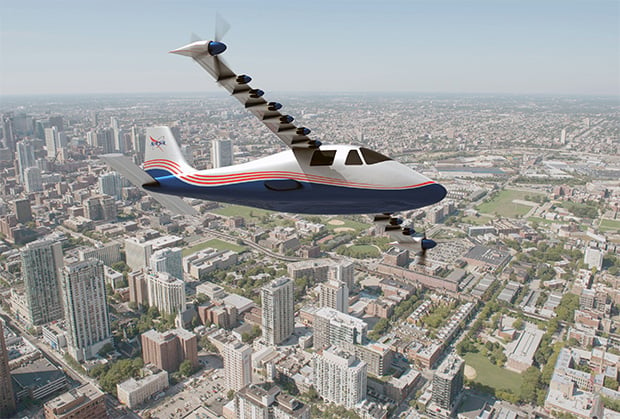NASA Unveils X-57 ‘Maxwell’ Electric Powered Plane Concept With 14 Motors
There's been a lot of focus on electric cars over the past few years, but roadways aren't the only place companies and organizations are putting effort into. Over at NASA, researchers are testing a new propulsion technology using an experimental electric airplane that's now been designated the X-57, or Maxwell, if you prefer to use its nickname. We'll stick with X-57 from here on out to avoid confusion with NVIDIA's prior generation GPU technology.
The X-57 takes to the sky with 14 electric motors tasked with turning propellers. Each one is integrated into a uniquely designed wing that's longer and skinnier than the original one found on the Italian-designed Tecnam P2006T, a twin-engine light aircraft that NASA modified into the X-57. A dozen of the electric motors are on the leading edge for take offs and landings, followed by one larger motor on each wing tip for cruising altitude.

NASA's aeronautical team is hoping the X-57 will validate the idea that distributing electric power across several motors integrated with an aircraft in such a manner will result in a five-fold reduction in the energy required for a private plane to cruise the skies at 175 miles per hour. The team also points out that there are other benefits, such as eliminating carbon emissions by using only batteries and lowering the demand for lead-based aviation fuel that's still in use.
"With the return of piloted X-planes to NASA’s research capabilities – which is a key part of our 10-year-long New Aviation Horizons initiative – the general aviation-sized X-57 will take the first step in opening a new era of aviation," NASA Administrator Charles Bolden said.
For travelers, energy efficiency at cruising altitude using X-57 technology could mean shorter flight times and less fuel usage. It also means a lower operation cost for small aircraft—NASA reckons the reduction could be as high as 40 percent. In most cases, the best fuel efficiency is achieved by flying slower than an aircraft is able to, but electric propulsion virtually negates the penalty for cruising at higher speeds.
This is part of a wider effort that could lead to the development of quieter, more efficient and environmentally friendly aircraft than today's commuter aircraft.
The X-57 takes to the sky with 14 electric motors tasked with turning propellers. Each one is integrated into a uniquely designed wing that's longer and skinnier than the original one found on the Italian-designed Tecnam P2006T, a twin-engine light aircraft that NASA modified into the X-57. A dozen of the electric motors are on the leading edge for take offs and landings, followed by one larger motor on each wing tip for cruising altitude.

NASA's aeronautical team is hoping the X-57 will validate the idea that distributing electric power across several motors integrated with an aircraft in such a manner will result in a five-fold reduction in the energy required for a private plane to cruise the skies at 175 miles per hour. The team also points out that there are other benefits, such as eliminating carbon emissions by using only batteries and lowering the demand for lead-based aviation fuel that's still in use.
"With the return of piloted X-planes to NASA’s research capabilities – which is a key part of our 10-year-long New Aviation Horizons initiative – the general aviation-sized X-57 will take the first step in opening a new era of aviation," NASA Administrator Charles Bolden said.
For travelers, energy efficiency at cruising altitude using X-57 technology could mean shorter flight times and less fuel usage. It also means a lower operation cost for small aircraft—NASA reckons the reduction could be as high as 40 percent. In most cases, the best fuel efficiency is achieved by flying slower than an aircraft is able to, but electric propulsion virtually negates the penalty for cruising at higher speeds.
This is part of a wider effort that could lead to the development of quieter, more efficient and environmentally friendly aircraft than today's commuter aircraft.

